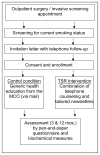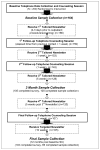Defining and understanding success at smoking reduction: a mixed-methods study
- PMID: 20807674
- PMCID: PMC2971661
- DOI: 10.1016/j.addbeh.2010.08.006
Defining and understanding success at smoking reduction: a mixed-methods study
Abstract
Much is known about the outcomes of different smoking reduction and cessation programs. However there is a lack of information about the degree to which such programs can achieve successes after initial failures. This study evaluated the patterns of success and failure during a smoking reduction intervention with a sample of 164 adult smokers (mean age 62; mean baseline smoking rate 21.2 cigarettes per day) who wanted to reduce their smoking but were not ready to attempt cessation. Success was defined by both self-reported number of cigarettes smoked assessed during counseling calls and carbon monoxide levels at 3 and 12 month follow-ups. There was a strong relationship between initial success/failure and eventual outcome using both assessment methods, and a moderate relationship between success categorization using the different methods (r=.43). Qualitative contextual data identified that types of travel, work and family environmental barriers experienced differed across success categories. This research confirms the importance of initial success in changing addictive behaviors and suggests directions for future research; including ways to enhance initial success, and the suggestion that more study is needed regarding the generalizability of these findings across settings and behaviors.
Copyright © 2010 Elsevier Ltd. All rights reserved.
Figures




References
-
- Baranowski T, Anderson C, Carmack C. Mediating variable framework in physical activity intervention: How are we doing? How might we do better? American Journal of Preventive Medicine. 1998;15:266–97. - PubMed
-
- Baranowski T, Lin LS, Wetter DW, Resincow K, Davis Hearn M. Theory as mediating variables: Why aren’t community interventions working as desired? Annals of Epidemiology. 1997;7:S89–S95.
-
- Bandura A. Self-Efficacy: The Exercise of Control. New York, NY: W. H. Freeman and Company; 1997.
-
- Carpenter MJ, Hughes JR, Solomon LJ, Callas PW. Smoking reduction and motivational advice increase future cessation among smokers not currently planning to quit. Journal of Counseling and Clinical Psychology. 2004;72:371–381. - PubMed
Publication types
MeSH terms
Substances
Grants and funding
LinkOut - more resources
Full Text Sources
Medical

